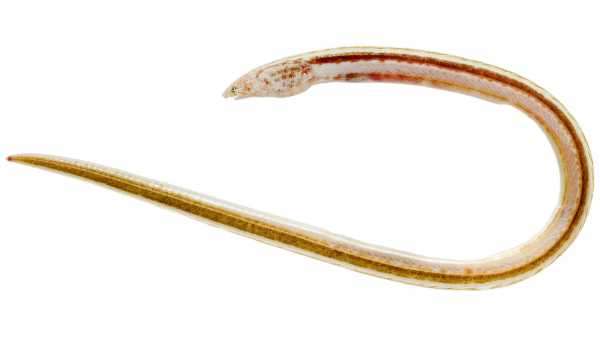
Ophichthidae is a family of sinuous fishes that are also known as snake eels. The species pictured here, Aprognathodon platyventris, is found in the western Atlantic Ocean.
Snake eels, a group of slender, sinuous fish, can perform a gruesome escape after they are swallowed by a bigger fish: They burst out of their predators’ stomachs. But that desperate and grisly bid for freedom may leave them worse off than before, new research reveals.
Most snake eel species’ tails end in a sharp, bony tip that they use for swiftly burrowing into the sandy sea bottom. When a predatory fish swallows a live snake eel, that tip can punch an escape hole in the predator’s stomach wall, which the eel then wriggles through tail-first.
However, this stomach-perforating maneuver doesn’t exactly land the snake eel in a better place. While the eel is not digested alive, it’s still trapped inside the predator’s body, and it soon dies in the gut cavity where it is eventually mummified, researchers reported in a new study describing this bizarre process.
The 351 species of snake eels that belong to the family Ophichthidae have long, tapering, snakelike bodies and live in tropical and temperate ocean waters around the world. Species vary greatly in size, with the smallest measuring under 2 feet (0.5 meters) long and the biggest measuring more than 8 feet (2.5 m) long, according to the Smithsonian Tropical Research Institute.
As early as 1934, scientific studies have described mummified corpses of individual dead snake eels preserved inside the body cavities of carnivorous fishes. For the new study, scientists conducted the first analysis of how widespread this peculiar outcome is, in waters around Australia.
Previously, researchers exploring parasites in a type of coastal fish called the black jewfish (Protonibea diacanthus), also found snake eels inside the fishes’ bodies, so the new study’s authors started there. They examined 335 P. diacanthus specimens collected from northern Australia, and found four species of preserved snake eels inside the body cavities of 19 P. diacanthus fish.
“Presence of these eels was high in comparison to previous reports,” the study authors reported.
In some cases, the snake eels’ preserved bodies were significantly degraded and hard to classify. The scientists confirmed finding at least three more species of snake eels inside 10 species of predatory fishes from Australian waters, in addition to P. diacanthus. Biodiversity of snake eels in northern Australia is “inadequately documented,” and investigations such as this could offer researchers the opportunity to discover new snake eel species, according to the study.
Some of these predatory fish also had partly-digested snake eels in their bellies that had not managed to escape, which told the scientists that the eels were a part of the fishes’ normal diet.
Snake eels are burrowing fish that frequently hide in seafloor sediments, so they likely have a higher tolerance for low-oxygen environments than some fish do. They therefore “could feasibly stay alive for longer inside the gut cavities of species that predate upon them, once ingested,” the scientists wrote in the study, though they did not specify how much longer a snake eel could survive such conditions.
Regardless, that ability doesn’t give snake eels much of an advantage, considering that the eels still slowly suffocate to death after their so-called escape, the study authors reported.
The findings were published online June 4 in the journal Memoirs of the Queensland Museum.
Sourse: www.livescience.com





